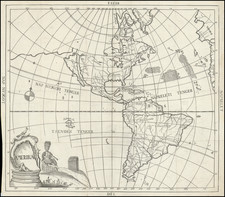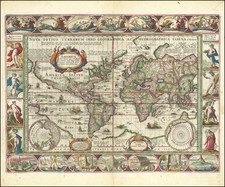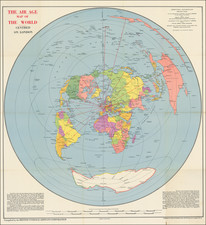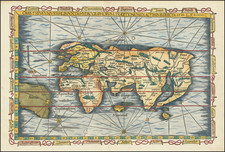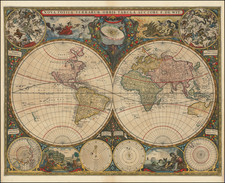A stunning example of this very scarce 17th Century English Map of the World, based upon the earlier map of Willem Blaeu by Pieter Van Den Keere and extensively reworked by the heirs of Jan Jansson, who had acquired the plate. The heirs, with Englishman Moses Pitt, attempted an ambitious atlas publication using, however, old reworked plates and of which only four of the intended twelve volumes were completed. The map retains the decorative borders of the original but has cartography updated to show California as an island, a reduction of the Great Southern Continent and an indication of the emerging Nova Hollandia (Australia) continent. The panels surrounding the map show images of the sun, moon and planets as gods--Luna, Mercury, Venus, Sol, Mars, Jupiter and Saturnus; representations of fire air, water and earth in human form; representations of the seasons--spring, summer, autumn and winter--as humans; and the 7 wonders of the ancient world. One of the most striking and highly sought after of all world maps. An old color example, which has been conserved and archivally backed to strengthen the paper. Clean wide margins. A visually superb example. Shirley 264 and 504.
Pitt was from Cornwall, where he was baptized at St. Teath in 1639. He was educated locally but moved to London when apprenticed to bookseller Robert Littlebury. At the end of his apprenticeship, in 1661, he was made free of the Haberdasher’s Company. His first books to be published with his own imprint appeared in 1667.
Pitt specialized in learned publications and imported scholarly works from continental Europe. He also published the writings of members of the newly formed Royal Society, including Robert Boyle, as well as high-ranking clergymen. In 1678, Pitt was the first bookseller to offer his wares via an auction.
Thanks in part to his ties to the Royal Society, Pitt announced in 1678 that he would publish a massive twelve-volume atlas of the world. The plates were to be based on Dutch maps, with a text written by Bishop William Nicholson and Richard Peers. However, only four volumes ever appeared.
Pitt, who was also managing several properties in Westminster and had expanded in a partnership to Oxford, was spread too thin. The cost of each volume of the atlas alone Pitt estimated at £1,000. One by one, his ventures turned foul, landing him in debtors’ prison for seven years. He died in London, but not in prison, in 1697.









![[World] Air France --](https://storage.googleapis.com/raremaps/img/small/93647.jpg)
